formerly eScholarship Editions


|
|
|
|
Your search for
'Contemporary Music' in subject
found 13 book(s). | Modify Search | Displaying 1 - 13 of 13 book(s) | |
| 1. | 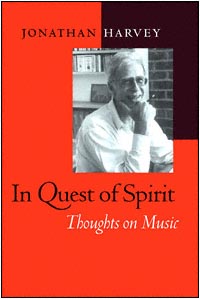 | Title: In quest of spirit: thoughts on music Author: Harvey, Jonathan 1939- Published: University of California Press, 1999 Subjects: Music | Composers | Contemporary Music | Religion Publisher's Description: The interests of the British composer Jonathan Harvey are wide and varied, embracing Christianity, Buddhism, eastern and western philosophy, aesthetics, science, and mysticism. All affect his musical thinking and are a part of this unusual and personal book, which is accompanied by a compact disc featuring works discussed by the author.Harvey explores aspects of music that he connects with spirituality: self-identity, ambiguity, unity, stasis, and silence. In the course of his explorations he offers corroborating statements about music and spirituality from sources ranging from Nietzsche to Oliver Sacks. The book and CD include samples of his own music as well as compositions by Mozart, Scriabin, Stockhausen, and others that help to illustrate the profoundness of what Harvey deems "the good listening experience."For Harvey, composing is his way of trying to live a life "skillfully" in the Buddhist sense. In Quest of Spirit is a window into his creative world and provides a sense of what music can mean at the moment of its inception. [brief] Similar Items |
| 2. | 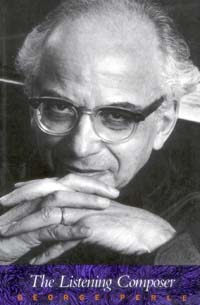 | Title: The listening composer Author: Perle, George 1915- Published: University of California Press, 1990 Subjects: Music | Contemporary Music | Composers Publisher's Description: George Perle takes us into the composer's workshop as he reevaluates what we call "twentieth-century music" - a term used to refer to new or modern or contemporary music that represents a radical break from the tonal tradition, or "common practice," of the preceding three centuries. He proposes that this music, in the course of breaking with the tonal tradition, presents coherent and definable elements of a new tradition. In spite of the disparity in their styles, idioms, and compositional methods, he argues, what unites Scriabin, Stravinsky, Bartók, and the Viennese circle (Schoenberg, Berg, and Webern) is more important than what separates them.If we are to understand the connections among these mainstream composers, we also have to understand their connections with the past. Through an extraordinarily comprehensive analysis of a single piece by Varèse, Density 21.5 for unaccompanied flute, Perle shows how these composers refer not only to their contemporaries but also to Wagner, Debussy, and Beethoven.Perle isolates the years 1909-10 as the moment of revolutionary transformation in the foundational premises of our musical language. He asks: What are the implications of this revolution, not only for the composer, but also for the listener? What are the consequences for the theory and teaching of music today? In his highly original answers, Perle relates the role of intuition in the listening experience to its role in the compositional process.Perle asserts that the post-Schoenbergian serialists have preoccupied themselves with secondary and superficial aspects of Schoenberg's twelve-tone method that have led it to a dead end but he also exposes the speciousness of current alternatives such as chance music, minimalism, and the so-called return to tonality. He offers a new and more comprehensive definition of "twelve-tone music" and firmly rejects the notion that accessibility to the new music is reserved for a special class of elite listeners. [brief] Similar Items |
| 3. | 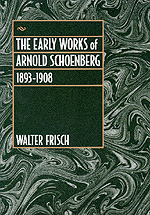 | Title: The early works of Arnold Schoenberg, 1893-1908 Author: Frisch, Walter Published: University of California Press, 1997 Subjects: Music | Composers | Contemporary Music | Musicology Publisher's Description: Here is the first full-scale account of Schoenberg's early tonal works, a rich repertory that music historians have tended to neglect or view as transitional to a mature atonal style.Between 1893 and 1908, Schoenberg created many genuine masterworks in the genres of Lieder, chamber music, and symphonic music. This book includes detailed critical analyses of such widely admired and performed compositions as Verklärte Nacht , Gurrelieder , and the First Chamber Symphony, as well as discussions of little-known but important songs and instrumental works from the earlier years.Drawing on original manuscript sources, on Schoenberg's musical environment, on a range of analytical methods, and on Schoenberg's own theories, Frisch traces the development of technique and aesthetic across this critical fifteen-year period of the composer's career. [brief] Similar Items |
| 4. | 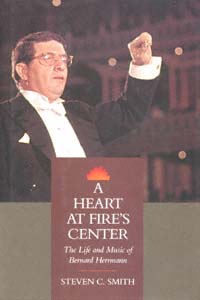 | Title: A heart at fire's center: the life and music of Bernard Herrmann Author: Smith, Steven C Published: University of California Press, 1991 Subjects: Cinema and Performance Arts | Film | Contemporary Music | Composers Publisher's Description: No composer contributed more to film than Bernard Herrmann, who in over 40 scores enriched the work of such directors as Orson Welles, Alfred Hitchcock, François Truffaut, and Martin Scorsese. In this first major biography of the composer, Steven C. Smith explores the interrelationships between Herrmann's music and his turbulent personal life, using much previously unpublished information to illustrate Herrmann's often outrageous behavior, his working methods, and why his music has had such lasting impact.From his first film ( Citizen Kane ) to his last ( Taxi Driver ), Herrmann was a master of evoking psychological nuance and dramatic tension through music, often using unheard-of instrumental combinations to suit the dramatic needs of a film. His scores are among the most distinguished ever written, ranging from the fantastic ( Fahrenheit 451 , The Day the Earth Stood Still ) to the romantic ( Obsession , The Ghost and Mrs. Muir ) to the terrifying ( Psycho ).Film was not the only medium in which Herrmann made a powerful mark. His radio broadcasts included Orson Welles's Mercury Theatre of the Air and The War of the Worlds . His concert music was commissioned and performed by the New York Philharmonic, and he was chief conductor of the CBS Symphony.Almost as celebrated as these achievements are the enduring legends of Herrmann's combativeness and volatility. Smith separates myth from fact and draws upon heretofore unpublished material to illuminate Herrmann's life and influence. Herrmann remains as complex as any character in the films he scored - a creative genius, an indefatigable musicologist, an explosive bully, a generous and compassionate man who desperately sought friendship and love. [brief] Similar Items |
| 5. | 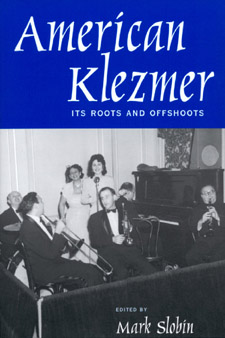 | Title: American Klezmer: its roots and offshoots Author: Slobin, Mark Published: University of California Press, 2002 Subjects: Music | Jewish Studies | American Music | Contemporary Music | Ethnomusicology Publisher's Description: Klezmer, the Yiddish word for a folk instrumental musician, has come to mean a person, a style, and a scene. This musical subculture came to the United States with the late-nineteenth-century Jewish immigrants from Eastern Europe. Although it had declined in popularity by the middle of the twentieth century, this lively music is now enjoying recognition among music fans of all stripes. Today, klezmer flourishes in the United States and abroad in the world music and accompany Jewish celebrations. The outstanding essays collected in this volume investigate American klezmer: its roots, its evolution, and its spirited revitalization. The contributors to American Klezmer include every kind of authority on the subject--from academics to leading musicians--and they offer a wide range of perspectives on the musical, social, and cultural history of klezmer in American life. The first half of this volume concentrates on the early history of klezmer, using folkloric sources, records of early musicians unions, and interviews with the last of the immigrant musicians. The second part of the collection examines the klezmer "revival" that began in the 1970s. Several of these essays were written by the leaders of this movement, or draw on interviews with them, and give firsthand accounts of how klezmer is transmitted and how its practitioners maintain a balance between preservation and innovation. [brief] Similar Items |
| 6. | 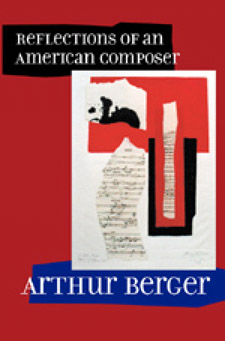 | Title: Reflections of an American composer Author: Berger, Arthur 1912- Published: University of California Press, 2002 Subjects: Music | American Music | Classical Music | Contemporary Music | Composers | Musicology Publisher's Description: In this engrossing collection of essays, distinguished composer, theorist, journalist, and educator Arthur Berger invites us into the vibrant and ever-changing American music scene that has been his home for most of the twentieth century. Witty, urbane, and always entertaining, Berger describes the music scene in New York and Boston since the 1930s, discussing the heady days when he was a member of a tight-knit circle of avant-garde young composers mentored by Aaron Copland as well as his participation in a group at Harvard University dedicated to Stravinsky. As Virgil Thomson's associate on the New York Herald Tribune and founding editor of the prestigious Perspectives of New Music, Berger became one of the preeminent observers and critics of American music. His reflections on the role of music in contemporary life, his journalism career, and how changes in academia influence the composition and teaching of music offer a unique perspective informed by Berger's abundant intelligence and experience. [brief] Similar Items |
| 7. | 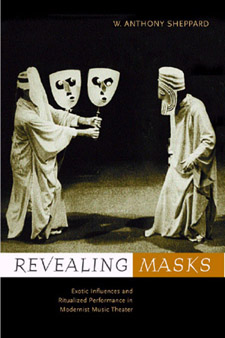 | Title: Revealing masks: exotic influences and ritualized performance in modernist music theater Author: Sheppard, William Anthony 1969- Published: University of California Press, 2001 Subjects: Music | American Music | Contemporary Music | Ethnomusicology | Opera | Musicology | Intellectual History Publisher's Description: W. Anthony Sheppard considers a wide-ranging constellation of important musical works in this fascinating exploration of ritualized performance in twentieth-century music. Revealing Masks uncovers the range of political, didactic, and aesthetic intents that inspired the creators of modernist music theater. Sheppard is especially interested in the use of the "exotic" in techniques of masking and stylization, identifying Japanese Noh, medieval Christian drama, and ancient Greek theater as the most prominent exotic models for the creation of "total theater." Drawing on an extraordinarily diverse - and in some instances, little-known - range of music theater pieces, Sheppard cites the work of Igor Stravinsky, Benjamin Britten, Arthur Honegger, Peter Maxwell Davies, Harry Partch, and Leonard Bernstein, as well as Andrew Lloyd Webber and Madonna. Artists in literature, theater, and dance - such as William Butler Yeats, Paul Claudel, Bertolt Brecht, Isadora Duncan, Ida Rubenstein, and Edward Gordon Craig--also play a significant role in this study. Sheppard poses challenging questions that will interest readers beyond those in the field of music scholarship. For example, what is the effect on the audience and the performers of depersonalizing ritual elements? Does borrowing from foreign cultures inevitably amount to a kind of predatory appropriation? Revealing Masks shows that compositional concerns and cultural themes manifested in music theater are central to the history of twentieth-century Euro-American music, drama, and dance. [brief] Similar Items |
| 8. | 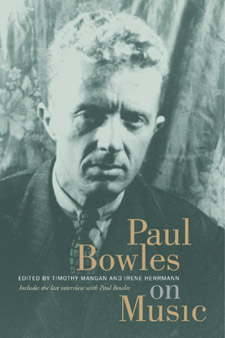 | Title: Paul Bowles on music Author: Bowles, Paul 1910- Published: University of California Press, 2003 Subjects: Music | American Music | Composers | Contemporary Music | American Literature | Film Publisher's Description: "It's an easy enough job if one has something to say," Paul Bowles remarked in a letter to his mother about his first foray into music criticism. And Paul Bowles, indeed, had plenty to say about music. Though known chiefly as a writer of novels and stories, Paul Bowles (1910-99) thought of himself first and foremost as a composer. Drawing together the work he did at the intersection of his two passions and professions, writing and music, this volume collects the music criticism Bowles published between 1935 and 1946 as well as an interview conducted by Irene Herrmann shortly before his death. An intimate of Aaron Copland and protégé of Virgil Thomson, Bowles was a musical sophisticate acquainted with an enormous range of music. His criticism collected here brilliantly illuminates not only the whole range of modernist composition but also film music, jazz, Mexican and Moroccan music, and many other genres. As a reviewer he reports on established artists and young hopefuls, symphonic concerts indoors and out, and important premieres of works by Copland, Thomson, Cage, Shostakovich, and Stravinsky, among others. Written with the austere grace of his better-known literary works, Bowles's criticism enhances our picture of an important era in American music history as well as our sense of his accomplishments and extraordinary contribution to twentieth-century culture. [brief] Similar Items |
| 9. | 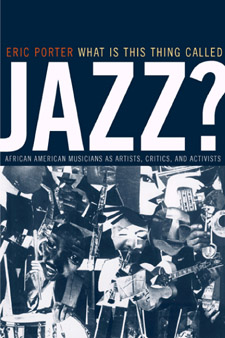 | Title: What is this thing called jazz?: African American musicians as artists, critics, and activists Author: Porter, Eric (Eric C.) Published: University of California Press, 2002 Subjects: Music | History | United States History | American Studies | African American Studies | American Music | Contemporary Music | Jazz Publisher's Description: Despite the plethora of writing about jazz, little attention has been paid to what musicians themselves wrote and said about their practice. An implicit division of labor has emerged where, for the most part, black artists invent and play music while white writers provide the commentary. Eric Porter overturns this tendency in his creative intellectual history of African American musicians. He foregrounds the often-ignored ideas of these artists, analyzing them in the context of meanings circulating around jazz, as well as in relationship to broader currents in African American thought. Porter examines several crucial moments in the history of jazz: the formative years of the 1920s and 1930s; the emergence of bebop; the political and experimental projects of the 1950s, 1960s and 1970s; and the debates surrounding Jazz at Lincoln Center under the direction of Wynton Marsalis. Louis Armstrong, Anthony Braxton, Marion Brown, Duke Ellington, W.C. Handy, Yusef Lateef, Abbey Lincoln, Charles Mingus, Archie Shepp, Wadada Leo Smith, Mary Lou Williams, and Reggie Workman also feature prominently in this book. The wealth of information Porter uncovers shows how these musicians have expressed themselves in print; actively shaped the institutional structures through which the music is created, distributed, and consumed, and how they aligned themselves with other artists and activists, and how they were influenced by forces of class and gender. What Is This Thing Called Jazz? challenges interpretive orthodoxies by showing how much black jazz musicians have struggled against both the racism of the dominant culture and the prescriptive definitions of racial authenticity propagated by the music's supporters, both white and black. [brief] Similar Items |
| 10. | 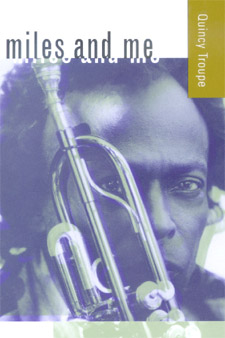 | Title: Miles and me Author: Troupe, Quincy Published: University of California Press, 2000 Subjects: Music | African American Studies | Autobiographies and Biographies | Contemporary Music | Jazz Publisher's Description: Quincy Troupe's candid account of his friendship with Miles Davis is a revealing portrait of a great musician and an intimate study of a unique relationship. It is also an engrossing chronicle of the author's own development, both artistic and personal. As Davis's collaborator on Miles: The Autobiography, Troupe--one of the major poets to emerge from the 1960s--had exceptional access to the musician. This memoir goes beyond the life portrayed in the autobiography to describe in detail the processes of Davis's spectacular creativity and the joys and difficulties his passionate, contradictory temperament posed to the men's friendship. It shows how Miles Davis, both as a black man and an artist, influenced not only Quincy Troupe but whole generations. Troupe has written that Miles Davis was "irascible, contemptuous, brutally honest, ill-tempered when things didn't go his way, complex, fair-minded, humble, kind and a son-of-a-bitch." The author's love and appreciation for Davis make him a keen, though not uncritical, observer. He captures and conveys the power of the musician's presence, the mesmerizing force of his personality, and the restless energy that lay at the root of his creativity. He also shows Davis's lighter side: cooking, prowling the streets of Manhattan, painting, riding his horse at his Malibu home. Troupe discusses Davis's musical output, situating his albums in the context of the times--both political and musical--out of which they emerged. Miles and Me is an unparalleled look at the act of creation and the forces behind it, at how the innovations of one person can inspire both those he knows and loves and the world at large. [brief] Similar Items |
| 11. | 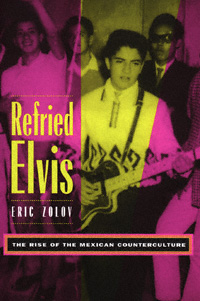 | Title: Refried Elvis: the rise of the Mexican counterculture Author: Zolov, Eric Published: University of California Press, 1999 Subjects: History | Latin American History | Popular Culture | Chicano Studies | Latin American Studies | Contemporary Music Publisher's Description: This powerful study shows how America's biggest export, rock and roll, became a major influence in Mexican politics, society, and culture. From the arrival of Elvis in Mexico during the 1950s to the emergence of a full-blown counterculture movement by the late 1960s, Eric Zolov uses rock and roll to illuminate Mexican history through these charged decades and into the 1970s. This fascinating narrative traces the rechanneling of youth energies away from political protest in the wake of the 1968 student movement and into counterculture rebellion, known as La Onda (The Wave). Refried Elvis accounts for the events of 1968 and their aftermath by revealing a mounting crisis of patriarchal values, linked both to the experience of modernization during the 1950s and 1960s and to the limits of cultural nationalism as promoted by a one-party state.Through an engrossing analysis of music and film, as well as fanzines, newspapers, government documents, company reports, and numerous interviews, Zolov shows how rock music culture became a volatile commodity force, whose production and consumption strategies were shaped by intellectuals, state agencies, transnational and local capital, musicians, and fans alike. More than a history of Mexican rock and roll, Zolov's study demonstrates the politicized nature of culture under authoritarianism, and offers a nuanced discussion of the effects of cultural imperialism that deepens our understanding of gender relations, social hierarchies, and the very meanings of national identity in a transnational era. [brief] Similar Items |
| 12. | 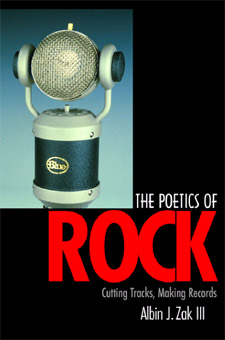 | Title: The poetics of rock: cutting tracks, making records Author: Zak, Albin Published: University of California Press, 2001 Subjects: Music | Popular Music | American Music | Musicology | Contemporary Music | American Studies | Media Studies | Popular Music Publisher's Description: After a hundred years of recording, the process of making records is still mysterious to most people who listen to them. Records hold a fundamental place in the dynamics of modern musical life, but what do they represent? Are they documents? Snapshots? Artworks? Fetishes? Commodities? Conveniences? The Poetics of Rock is a fascinating exploration of recording consciousness and compositional process from the perspective of those who make records. In it, Albin Zak examines the crucial roles played by recording technologies in the construction of rock music and shows how songwriters, musicians, engineers, and producers contribute to the creative project, and how they all leave their mark on the finished work. Zak shapes an image of the compositional milieu by exploring its elements and discussing the issues and concerns faced by artists. Using their testimony to illuminate the nature of record making and of records themselves, he shows that the art of making rock records is a collaborative compositional process that includes many skills and sensibilities not traditionally associated with musical composition. Zak connects all the topics--whether technical, conceptual, aesthetic, or historical--with specific artists and recordings and illustrates them with citations from artists and with musical examples. In lively and engaging prose, The Poetics of Rock brilliantly illustrates how the musical energy from a moment of human expression translates into a musical work wrought in sound. [brief] Similar Items |
| 13. | 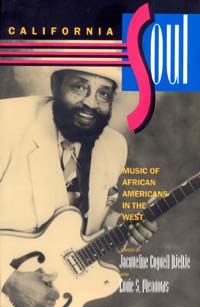 | Title: California soul: music of African Americans in the West Author: DjeDje, Jacqueline Cogdell Published: University of California Press, 1998 Subjects: Music | African American Studies | American Studies | California and the West | Californian and Western History | United States History | Contemporary Music | Jazz Publisher's Description: This new series, co-sponsored with The Center for Black Music Research of Columbia College, seeks to increase our understanding of black music genres and their importance to the cultures of the Atlantic world, including their influence on African musical styles. Books in the series will examine the wide-ranging music of the African diaspora - including the folk-derived musical styles of the Americas as well as European-influenced concert hall music of the entire black Atlantic world - by analyzing issues critical to our interpretation of the music itself and exploring the relationships between music and the other black expressive arts.Focusing on blues, jazz, gospel, rhythm and blues, and soul music, California Soul is one of the first books to explore the rich musical heritage of African Americans in California. The contributors describe in detail the individual artists, locales, groups, musical styles, and regional qualities, and the result is an important book that lays the groundwork for a whole new field of study. The essays draw from oral histories, music recordings, newspaper articles and advertisements, as well as population statistics to provide insightful discussions of topics like the California urban milieu's influence on gospel music, the development of the West Coast blues style, and the significance of Los Angeles's Central Avenue in the early days of jazz. Other essays offer perspectives on how individual musicians have been shaped by their African American heritage, and on the role of the record industry and radio in the making of music. In addition to the diverse range of essays, the book includes the most comprehensive bibliography now available on African American music and culture in California. [brief] Similar Items |